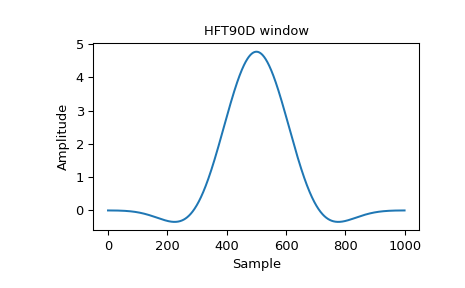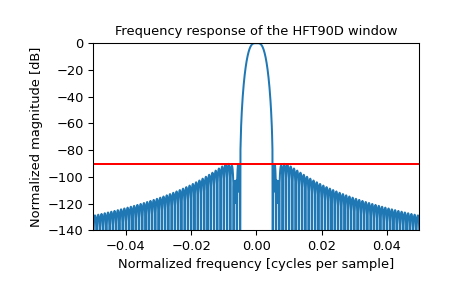scipy.signal.windows.general_cosine#
- scipy.signal.windows.general_cosine(M, a, sym=True)[source]#
Generic weighted sum of cosine terms window
- Parameters:
- Mint
Number of points in the output window
- aarray_like
Sequence of weighting coefficients. This uses the convention of being centered on the origin, so these will typically all be positive numbers, not alternating sign.
- symbool, optional
When True (default), generates a symmetric window, for use in filter design. When False, generates a periodic window, for use in spectral analysis.
- Returns:
- wndarray
The array of window values.
References
[1]A. Nuttall, “Some windows with very good sidelobe behavior,” IEEE Transactions on Acoustics, Speech, and Signal Processing, vol. 29, no. 1, pp. 84-91, Feb 1981. DOI:10.1109/TASSP.1981.1163506.
[2]Heinzel G. et al., “Spectrum and spectral density estimation by the Discrete Fourier transform (DFT), including a comprehensive list of window functions and some new flat-top windows”, February 15, 2002 https://holometer.fnal.gov/GH_FFT.pdf
Examples
Heinzel describes a flat-top window named “HFT90D” with formula: [2]
\[w_j = 1 - 1.942604 \cos(z) + 1.340318 \cos(2z) - 0.440811 \cos(3z) + 0.043097 \cos(4z)\]where
\[z = \frac{2 \pi j}{N}, j = 0...N - 1\]Since this uses the convention of starting at the origin, to reproduce the window, we need to convert every other coefficient to a positive number:
>>> HFT90D = [1, 1.942604, 1.340318, 0.440811, 0.043097]
The paper states that the highest sidelobe is at -90.2 dB. Reproduce Figure 42 by plotting the window and its frequency response, and confirm the sidelobe level in red:
>>> import numpy as np >>> from scipy.signal.windows import general_cosine >>> from scipy.fft import fft, fftshift >>> import matplotlib.pyplot as plt
>>> window = general_cosine(1000, HFT90D, sym=False) >>> plt.plot(window) >>> plt.title("HFT90D window") >>> plt.ylabel("Amplitude") >>> plt.xlabel("Sample")
>>> plt.figure() >>> A = fft(window, 10000) / (len(window)/2.0) >>> freq = np.linspace(-0.5, 0.5, len(A)) >>> response = np.abs(fftshift(A / abs(A).max())) >>> response = 20 * np.log10(np.maximum(response, 1e-10)) >>> plt.plot(freq, response) >>> plt.axis([-50/1000, 50/1000, -140, 0]) >>> plt.title("Frequency response of the HFT90D window") >>> plt.ylabel("Normalized magnitude [dB]") >>> plt.xlabel("Normalized frequency [cycles per sample]") >>> plt.axhline(-90.2, color='red') >>> plt.show()

